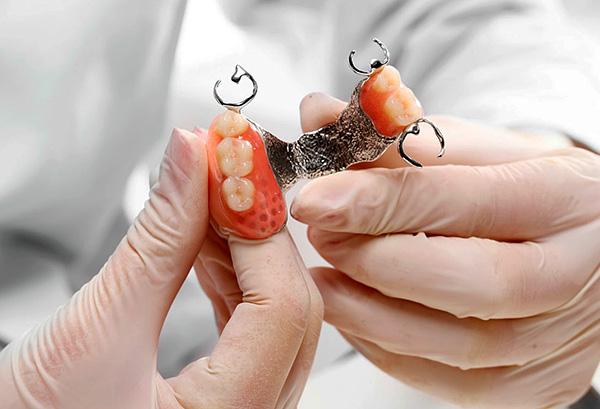
Next you will find out:
- What is a byugel prosthesis and how do such structures look in general on the upper jaw;
- In what cases it is recommended to use clasp prosthetics, and when this should be avoided;
- How exactly the prosthesis is attached to the jaw and what is important to know about different types of fastening in advance;
- And why, in fact, install a byugel on the upper jaw - maybe it is better to prefer a removable acrylic plate prosthesis?
- How a partial denture is made and how long you will have to wait for it since the first visit to the clinic;
- Is it possible to speed up the addiction to the prosthesis and how to properly care for it in order to save yourself from future problems;
- How much are the byugel prostheses and how much their cost correlates with the prices for implantation.
... And also some other interesting and important from practical point of view nuances of clasp prosthetics.
When, for one reason or another, a dent appears in the dentition, then one or more teeth (or even all at once) can be missing with a prosthesis. This is where the most interesting thing arises - how to choose a denture that would allow you to chew normally, and would not interfere in your mouth, and that it would be so technologically advanced that everything would look as if it were your own teeth, and not some kind of “false jaw”.
And since we are talking about dental prosthetics in the upper jaw, it is also especially important that the prosthesis be held very securely and not fly under its weight while eating or, even worse, when talking.
Well, the clasp prosthesis in this respect has quite significant advantages. Today, such designs are quite popular in prosthetic dentistry on both the upper and lower jaw.
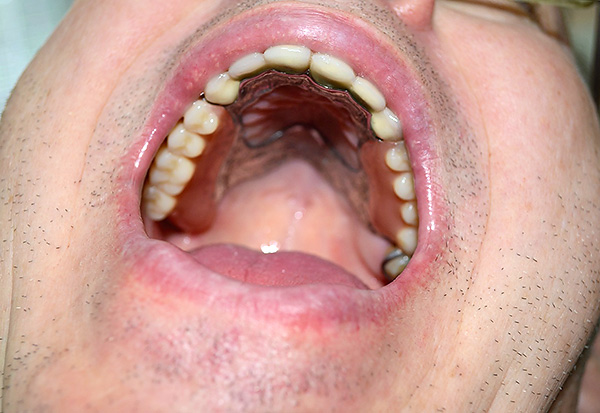
On a note
The basis of the partial denture is a plastic or metal arc (the word “bugel” is translated from German as “arc”) - this arc ensures the integrity and rigidity of the whole structure, playing an important role in the distribution of the chewing load. The arc is attached to the plastic base, imitating the gum, and on the base, in turn, are attached artificial teeth.
The photo below shows an example of a partial denture on the upper jaw:
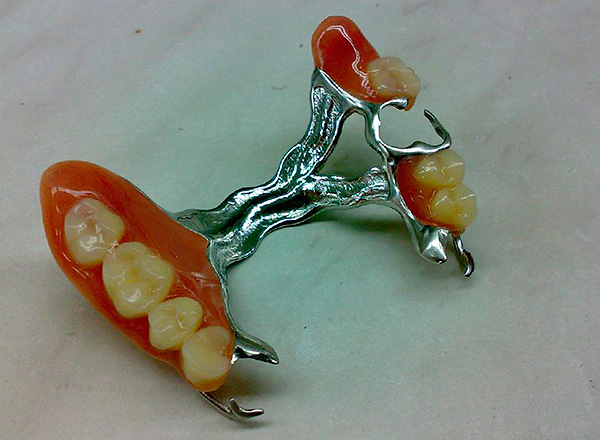
The photo shows that the basis of the prosthesis is a metal arc, repeating the individual anatomical shape of the patient's upper jaw. The arc is connected to two bases on which plastic teeth are mounted. In this example, it is clearly seen that not only gums and the palate, but also a certain amount of teeth that are not left in the upper jaw, are needed to support the byuly prosthesis.
Generally speaking, all dentures are divided into fixed (bridges, crowns, tabs, etc.) and removable (there are, however, conditionally removable, which can only be removed by a doctor with special tools). As you already understood, the clasp denture is an example of a removable denture, that is, the owner can easily remove it himself.
So, some dentists believe that with the loss of a large number of teeth and limited finances, and even if there are sufficient funds in some clinical cases (when there are contraindications to implantation of teeth) byugel prosthetics can become almost the only acceptable option to restore aesthetics and chewing function. .

Is it really, or such statements are banal advertising? Anyway,Do you need a clasp prosthesis, or is there a more reliable, convenient and cheap design for dentures in the upper jaw? Let's understand ...
Indications and contraindications to the clasp prosthetics
Before solving these or other problems with the help of a clasp prosthesis, it is useful to have an idea in which cases it can be installed and lived with it comfortably for many years, and when such a prosthesis is contraindicated because of possible harm to health.
So, to begin with, let us note the indications for the bypass prosthetics, that is, those situations where the "byugel" is permitted as a removable orthopedic construction:
- Multiple defects of the dentition;
- One- and two-sided end defects of the dentition;
- The absence of more than 4 teeth in the anterior part of the upper and / or lower jaw;
- The loss of more than 3 "back" teeth;
- Defects in the dentition associated with gum disease (periodontitis, periodontal disease).
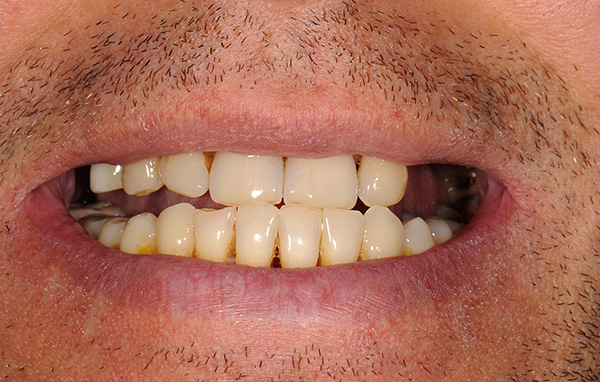
To these indications, you can also add some nuances of the clasp prosthetics as a whole. In particular, for a normal installation of the clasp prosthesis, at least 5 teeth should be present on your upper jaw in order to evenly distribute the pressure during chewing.It is also important to consider that the abutment teeth should not have inflammatory processes on the roots.
The characteristics of the bite can also influence the course of future prosthetics, and in some clinical cases it is possible to install a clasp prosthesis only with certain types of fastening (we will talk about fastenings a little lower).
Now about the contraindications of clasp prosthetics. The installation of upper and lower partial dentures is contraindicated in:
- Low abutment teeth, as well as in the absence of the necessary teeth for fixing the bugel;
- Common diseases and diseases of the oral cavity in the acute stage;
- Diseases leading to loss of bone tissue;
- Deep bite;
- Pregnancy and lactation;
- Radiation therapy;
- Short bridle tongue (for the prosthesis on the lower jaw);
- Addiction;
- Mental disorders;
- Allergies to material prosthesis.

On a note
In fact, this list of contraindications is very conditional, if only because some of them (for example, diseases in the acute stage, radiation therapy, short frenulum of the tongue, etc.) are eliminated for one or another period of time.
Pregnancy and lactation are not always considered by the attending physicians, as a reason to abandon the appropriate in a given situation byugel. Allergy to the materials of the partial denture (in the case of the upper jaw may be, for example, irritation of the sky) can be overcome by using other types of alloys or special protective coatings on the same design.
How a prosthesis can be mounted on the upper jaw: advantages and disadvantages of different types of fastening
As you understand, when installing a partial denture on the upper jaw, the attachment reliability and its inconspicuousness for others are at the forefront: the prosthesis should not move down under its weight, and the attachments should not fall into the smile area, if possible. And if the situation is generally not bad with the reliability of fastening byugel, then there are nuances with aesthetics ...
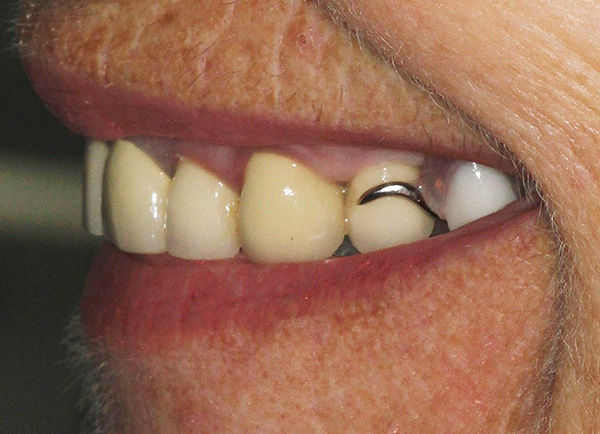
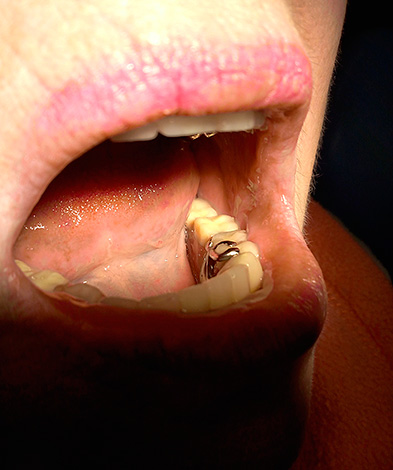
The fasteners of the upper and lower partial dentures are divided into the following types:
- Clammer;
- Castle
On a note
There is also a fixation of the clasp prosthesis on telescopic crowns, but it is used quite rarely in Russia due to the increased complexity and, as a result, the high cost.The principle of the method is that metal crowns are made and fixed on the abutment teeth (that is, this part of the system is not removable). And on the basis of the removable clasp prosthesis, wider metal-ceramic crowns are fastened, which are able to fit tightly on the supporting teeth with metal crowns. It turns out that the crown is put on the crown, which is why such a mount is called telescopic.
The photo below shows an example of a clasp prosthesis on telescopic crowns on the lower jaw:
And in the following photos - an example of the use of clasp prosthesis on telescopic crowns for prosthetics in the upper jaw:
Such byugel dentures are made in large dentistry and cost on average 2-3 times more expensive than the “classical” versions (with clamp and lock fastenings). However, if you want the clasp prosthesis on your upper jaw to look perfect in terms of aesthetics - then it is the telescopic option that may be the best solution.
Klammer fixation of the clasp dentures is today one of the most popular.A klammer is a kind of hook that performs not only a holding but also a supporting function: about a third of the chewing load falls on the supporting teeth with a clasp, and two-three on the gum.
Photo of clasp denture with clasps:
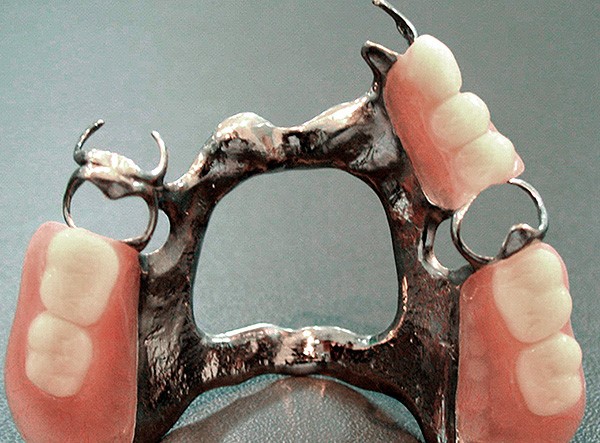
The main disadvantage of klammmernoy fixation is not always the ideal aesthetics. Simply put, with a smile and a conversation, these same clasps (hooks) will be visible on the teeth. Especially well visible are clasps that attach to the teeth of the upper jaw in the smile zone.
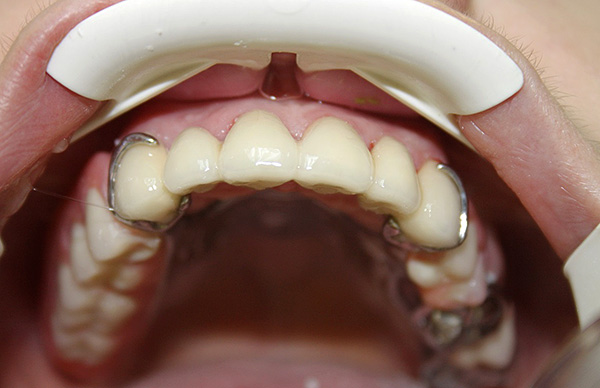
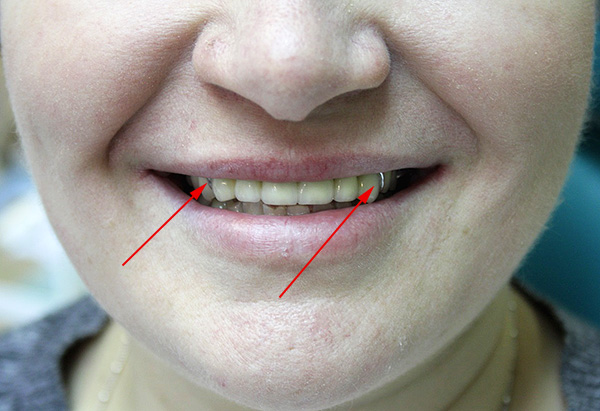
Nevertheless, due to the simplicity and reliability of the design, it is clasters that are today the most common way of holding upper and lower denture prostheses in the mouth. There are the following types of them:
- Restraints;
- Supporting;
- Combined.
They differ in the nature of the transfer of chewing load: on the mucous membrane of the gums and (or) supporting teeth.
On a note
A reasonable question may arise: if it is necessary to install a clasp prosthesis on the clasps, is it necessary to cover the abutment teeth with crowns?
So, the claspled clasp prosthesis can be installed without turning the enamel of the teeth under the crown, provided that the supporting teeth are healthy (for example, they are not too destroyed by caries). If a significant part of the tooth is destroyed, then in order not to spoil the supporting teeth finally, it is advisable to install crowns on them.
The next type of mounting prosthetic dentures - locks, otherwise called attachments. Castle byugelny prostheses have several advantages over clamp dentures, and their main advantage is higher aesthetics. In other words, for the surrounding attachment of the prosthesis will not be noticeable.
The fact is that the locks, unlike the clasps, are “hidden” from the inside of the abutment teeth: one part of the lock is on the crown, which is put on the abutment tooth, and the second part is located on the basis of the clasp prosthesis. At installation of an artificial limb the lock just latches.
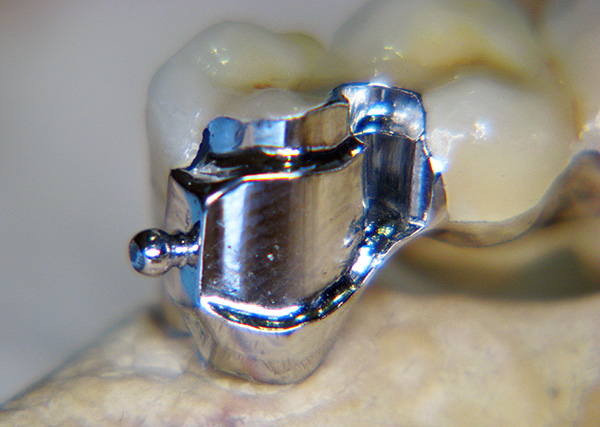
Below is a photograph of a clasp prosthesis on the locks (attachments) on the upper jaw:
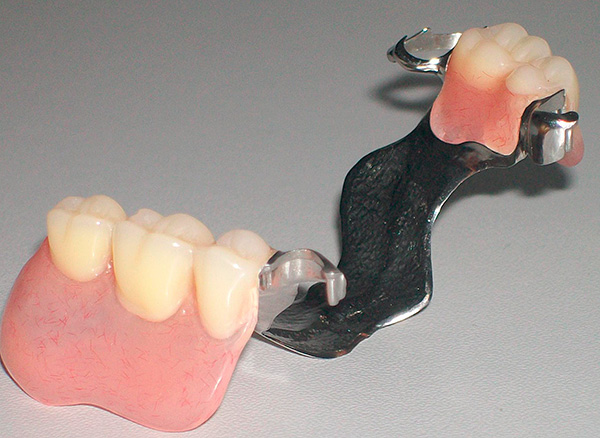

On a note
The locks have a lot of advantages in terms of functionality, that is, in the nature of the distribution of pressure on the prosthesis.Attachments allow you to better adapt and fix the byugel for comfortable chewing of food, which ultimately determines the convenience of wearing and using a prosthesis.
At first glance it may seem that the denture on the locks will be problematic to remove - in fact, this is not so: the design can be easily removed for periodic cleaning.
However, the locking clasp prostheses also have significant drawbacks:
- The increased complexity of manufacturing determines their higher price in comparison with the clamping prostheses (in some clinical cases the price is comparable to the cost of prostheses on telescopic crowns);
- In addition, the installation of the clasp prosthesis on the locks involves turning several abutment teeth to install a metal-ceramic crown on them.

Feedback:
“... My husband is now putting. We looked at other options, but nothing else happens. They decided to do it on the clasps. The orthopedist warned that the addiction would last for about a month. The problem is that we have a small choice, either implants or a prosthesis. And implants are very expensive and they would have to be put a lot. ”
Irina, St. Petersburg
Features of the partial denture on the upper jaw
As a rule, the installation of an upper partial denture is used in cases when there are few or most teeth (especially terminal ones) in the upper jaw, a flat palate (usually in older people due to atrophy of the alveolar processes) and no possibility of permanent prosthetics (for example, on implants ).
Constructions of cusp dentures on the upper jaw can vary significantly. For example, the connecting arch of the prosthesis can be on the front, middle or back of the sky, and the shape of the dental arch can be in the form of a horseshoe, a band or a ring. Thus, the clasp prosthesis will look different, depending on the nuances of a particular clinical situation.
Here are some pictures of the denture prostheses on the upper jaw:
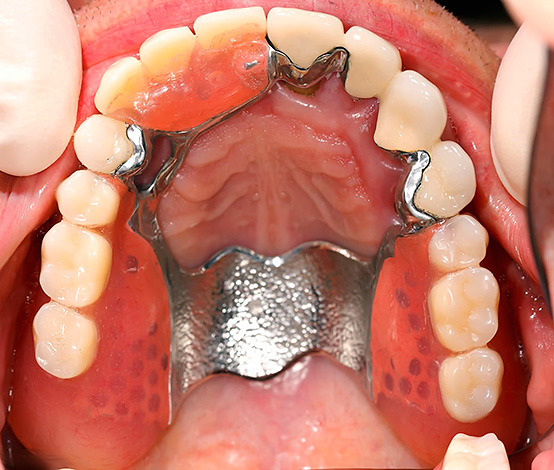
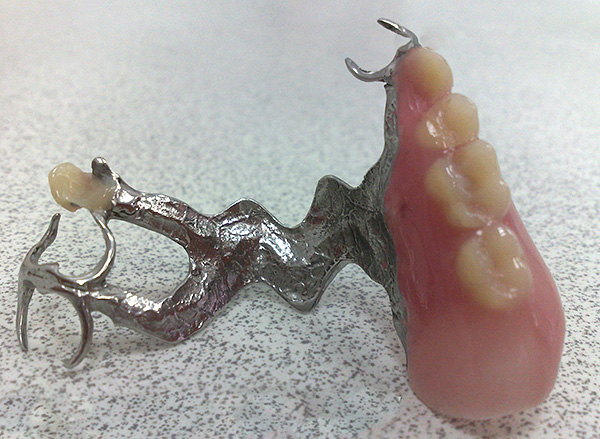
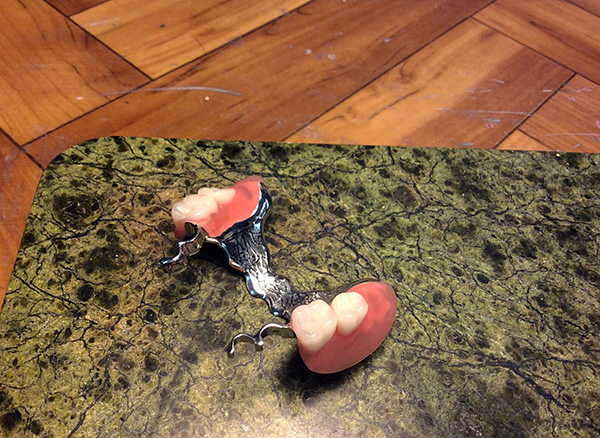
As regards the use of clamp or clamp fixation in upper jaw prosthetics, this is largely determined not only by the clinical prerequisites, but also by the patient’s financial resources (the prosthesis on attachments will cost significantly more).
To the note: is it possible to install a full partial denture on the upper jaw?
As you understand, a complete prosthesis is made in the absence of all teeth, and in the context of the clasp prosthetics, it is required that several abutments in the jaw be at once for adequate retention and functioning of the structure. Therefore, in the absence of all the teeth in the upper jaw, it will not be possible to install a partial denture.
However, this type of prosthesis is possible: initially, implantation is carried out with the installation of at least 4 implants, and then a full prosthesis is performed based on the installed implants.
Sometimes, in pursuit of cheapness when denturing teeth in the upper jaw, patients are still leaning in favor of installing removable laminated prostheses made of acrylic plastic. What is useful to keep in mind on this account:
- Classical acrylic prostheses often cause allergies and prosthetic stomatitis, in contrast to arc structures;

- In addition, having a large prosthetic bed, acrylic prostheses can not only rub the mucous membrane, but generally do not allow them to be worn because of the increased vomiting reflex (as a result, if you read the reviews, patients simply put them on the shelf and do not wear them).Byugel’s arc is rather narrow and minimizes such unpleasant phenomena.
Could a special glue be required for more reliable fixation of the partial denture on the upper jaw?
Many older people know firsthand that dentures can “stick out” to the sky, and often for their successful retention, medical adhesives (gels) are required. So, the byugel is held in the mouth according to a different principle - that is why reliable support teeth are so important for this prosthesis, to which the prosthesis will be attached.
Nevertheless, despite the obvious shortcomings of plate acrylic prostheses, we should not forget that their price, unlike bügel, is much more accessible to wide sections of the population. And what is important, in a number of clinical situations such prostheses in fact are not inferior to the byugelny, especially with properly planned treatment, when the pros and cons are taken into account.
Feedback
“A year ago, my mom was given a bump prosthesis instead of a removable jaw, which her friends-neighbors in the country wear. And I swear, she doesn’t take it off even for the night, she just brushes it constantly after eating to a shine with a brush and toothpaste.Really byugel miniature and can not be distinguished from their teeth. The neighbors even thought that we had forked over half a million and put implants to mommy. Looks like the best Hollywood film ... "
Violetta, 35 years old, Omsk
Stages of making partial denture
The dentist who makes the prosthetic plan is an orthopedist. It is he who determines all the nuances of the process, and above all - which teeth to choose to support the future clasp prosthesis, and which ones are due to their deplorable state to be removed.
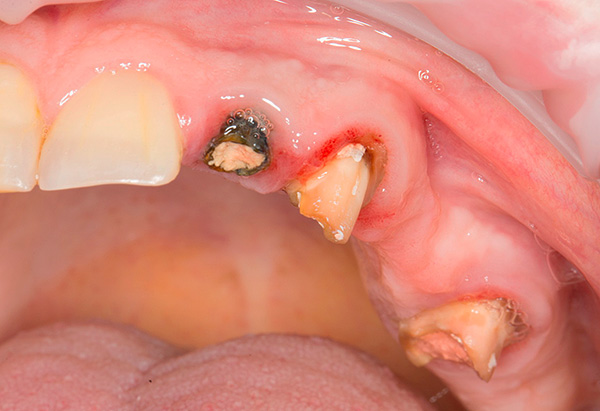
On a note
Movable teeth, as well as severely damaged by the carious process (well below the level of the gums) and teeth with large cysts are most often to be removed, which is carried out by a dentist-surgeon. If, for some reason, it is impossible to adequately treat the canals to prepare the tooth for support, it is also usually subject to removal.
On average, prosthetics take about 1.5-2 months, sometimes less.
Consider the example of the stages of manufacturing the partial denture on the upper jaw:
- At the first stage, the orthopedic surgeon makes impressions (“casts”) of the patient’s upper and lower jaws;
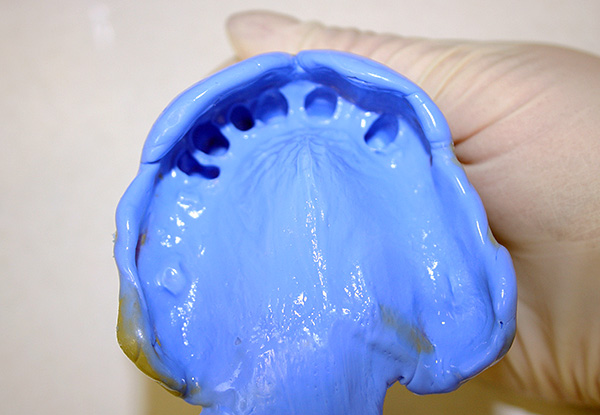
It is interesting
Previously, for the removal of dental impressions actively used gypsum. The problem was that when extracting hardened plaster from the oral cavity, there were rare cases of removal of mobile teeth. Later, much more sophisticated impression masses appeared, which are easily and without problems removed, causing minimal discomfort to the patient.
- At the second stage, the dental technician manufactures special working models of the upper and lower jaws and temporary crowns in the laboratory: if the future partial denture has locks or telescopic crowns, then it will be important to cover the supporting teeth with “temporary make-ups”;
- At the third stage, the teeth are turned and then covered with temporary crowns;
- Then impressions for the byugel are taken, permanent crowns are made from them;
- The fifth stage consists in fitting the fabricated cage of the partial denture in the patient's mouth;
- Then comes the final stage of the prosthesis manufacture in the laboratory;
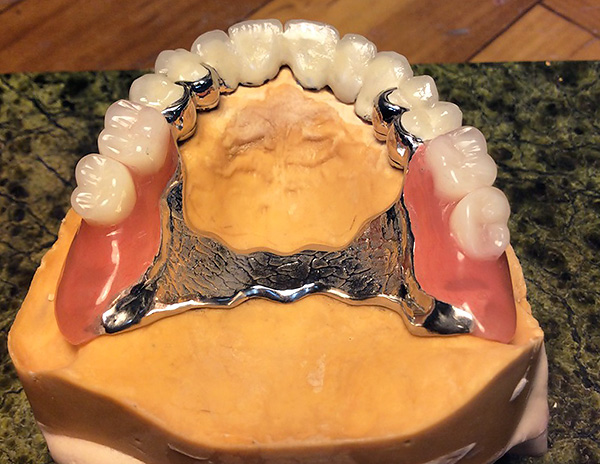
- At the last stage, the prosthesis is rented to the patient for use, and recommendations are given for care.
How to properly care for the prosthesis and how long it will have to get used to it
At first glance it may seem that as soon as the by-piece prosthesis is an artificial construction, then the bacteria are not afraid of it, and therefore, it would seem to be not so important to care for it, unlike native teeth and gums. In fact, everything is exactly the opposite: any denture requires care, and even more thorough than native teeth.
There are not too many rules for caring for prosthetic dentures - their observance not only prolongs the life of the structure and preserves its initial aesthetic parameters, but also significantly reduces the risk of inflammation of the tissues adjacent to the prosthesis (gums, as well as the palate, when it comes to upper jaw).

The principles of care for the prosthesis are as follows:
- It is recommended to rinse the prosthesis with water after each meal;
- Cleaning the partial denture is done in the same way as cleaning your own teeth, that is, using a regular toothbrush and regular toothpaste (without the use of coarse abrasives and chemicals such as soda, bleach, citric acid, and without the use of hot water);
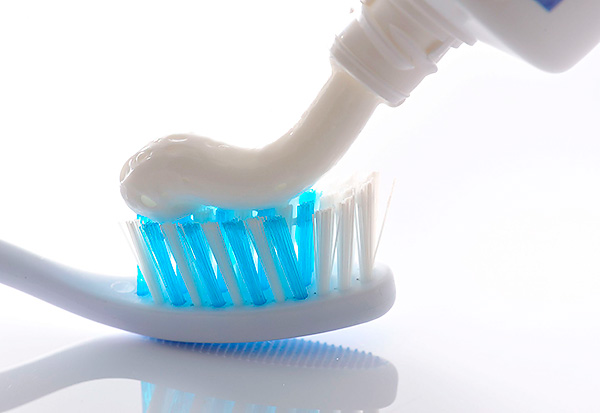
- Cleaning artificial teeth from plaque should be carried out at least 2-3 times a day after eating with a toothbrush and toothpaste. It is better to choose a paste without a whitening effect. It is better to coordinate any variants of experiments with the doctor, for example, the use of special solutions for cleaning prostheses.
On a note
The service life of the partial denture usually does not exceed 10 years, subject to careful care of it. It is also necessary to correct the prosthesis in time as necessary (the need for correction should be determined by the doctor at least once a year).
As for getting used to the prosthesis - yes, there are often certain problems. Sometimes byugel dentures on the upper and lower jaw can be felt by the patient as a foreign body in the oral cavity. Moreover, the severity of this problem is determined not so much by the quality of the fabrication of the structure as by the individual characteristics of the person, which are also associated with the psycho-emotional state at a given time and even with temperament.
The more the patient is set to a positive outcome, the more calmly he treats a slight discomfort, the less there are problems with getting used to the prosthesis, and vice versa.
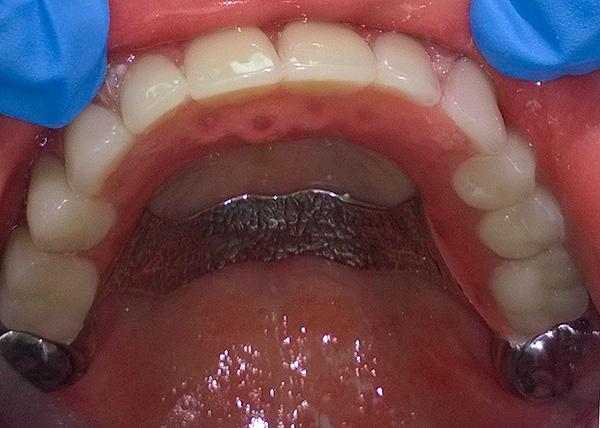
Usually a violation of diction, chewing, some pain at first, etc.- these are all temporary problems, which after the prosthetics are not expressed very strongly, and are overcome within a few days. Orthopedic dentists are well aware of these nuances and themselves offer various methods of accelerated adaptation to the prosthesis.
On a note
For example, when chewing (unaccustomed) is difficult, you should try to chew slowly and, if possible, “practice” quite often: you can break up meals into 8 small portions, which you can eat during the day. If you have problems with diction, it is recommended to sing and communicate with friends and family more.
Training and patience lead to success in the vast majority of cases, and it is extremely rare to adjust the prosthesis due to problems with habituation.
At what price can a bullet denture on the upper jaw cost, and is there any way to save money?
First of all, it should be borne in mind that each clinical situation is individual, therefore, prices for byugel prosthetics can vary significantly. Let's take a look at what prices can be roughly guided on average.
If, for example, in the upper jaw, the denture prosthesis is “restored” to 5–7 teeth,then the cost of prosthetics will average 50-100 thousand rubles (the price, of course, is very approximate, and will also depend on the level of the clinic). Bugel with clamp fixation cost less than clasp dentures on locks. In turn, dentures with locking fixation will be cheaper than those fixed on telescopic crowns.
The number of attachments and crowns also directly affects the final cost of the partial denture.
On a note
As already noted above, byugel dentures are significantly more expensive than removable laminar dentures made of acrylic plastic (sometimes many times). This is especially true of the Quadrotti prostheses (Quattro Ti), resembling removable nylon prostheses and characterized by high aesthetics and wearing comfort.

If the prices for the clasp prosthetics are compared with dental implantation, then the situation is as follows. The cusp dentures are most often chosen to replace a large number of missing teeth, so even if the final cost of the prosthesis is 100-150 thousand rubles, it will still be much cheaper than installing several implants on the upper or lower jaw and then prosthetics on them with metal ceramics. .

Feedback:
“I put myself two prostheses. Prior to that, chewed 15 teeth, so what's the point, the pieces flew directly into the stomach. Health problems started, you don't want it, but you had to put in your teeth. In short, I was advised by the blugel prosthesis, it looks tempting, the price is acceptable. First, the doctor put him in a chair and advised me to put 8 implants with crowns in the next room, counted 380 thousand for all my work. Yes, my toothless jaw hardly fell off from such a price. I immediately refused, then he offered a denture prosthesis for 40. It turned out that a trick, 40 pieces is only one jaw, but I was reassured that 80 would not work, and the cost would be at 70. So approximately, it turned out ... ”.
Maxim, Nizhnekamsk
And in conclusion, one important point should be noted, which is often forgotten (yes, to say nothing, many patients do not know about it at all). Clasp prostheses, as well as all removable laminar prostheses ("false jaws") are considered by dentists to be a temporary way of restoring aesthetics and chewing function.
The fact is that, despite all the technological tricks, no byugel is able to stop the atrophy of the jaw bone tissue, which will not receive the proper chewing load.The loss of bone tissue, in turn, will lead to a gradual change in facial features and some other undesirable processes associated with the work of the entire dental system.
But, as they say, “there is nothing more permanent than temporary,” and in Russia today the realities are such that patients use byugel prostheses precisely as permanent.
Interesting video about different types of prostheses
What are the types of removable prosthetic teeth and how the corresponding prostheses differ in reliability and aesthetics



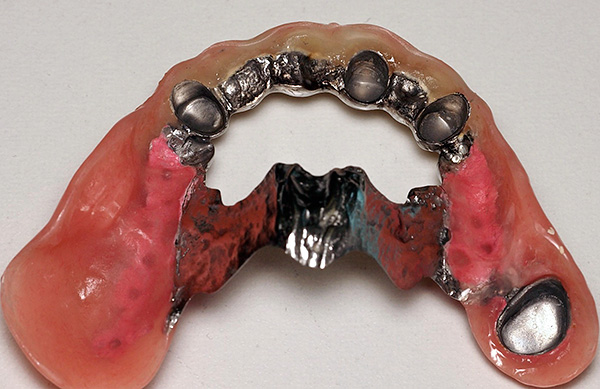
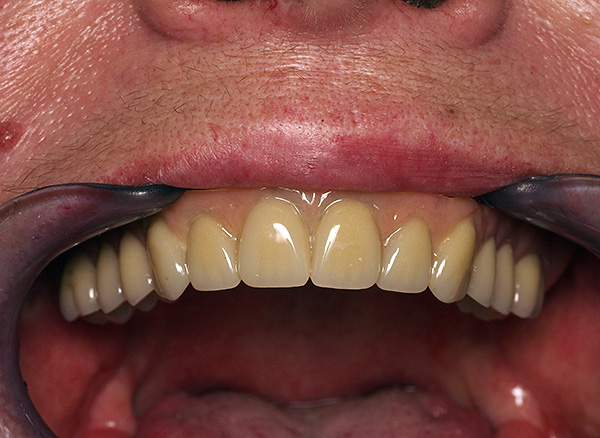
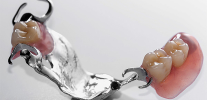
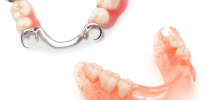
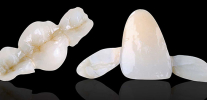
I have been given a denture prosthesis on the upper jaw for half a year now, but I can’t wear it, it’s really bad for me, it’s very dry in the mouth and the palate just goes numb by the evening. Maybe I did something wrong?
Hello! I think that a correction of the prosthesis is necessary, as he definitely should not crush. It is strange that the sky grows dumb, because the byugel does not have a classical plate, like a plate prosthesis. Refer to the dentist, orthopedist, you can even to someone who did. A professional never refuses his job. The most difficult thing is to determine the cause of this problem, taking into account the nuances of the prosthesis. However, it is worth doing to continue to fix the prosthesis so as not to think about such problems for years. All this is done only in the chair at the orthopedist. You do not trust your own doctor - you can change, but it will obviously be more expensive.
Tell me, please, where in St. Petersburg can I install the Quadrotti clasp prosthesis on the upper jaw?
Very intelligible and detailed description.Thanks for the very valuable information.
I would not advise anyone to put the clasp prosthesis, a terrible inconvenience, a whole house in the mouth. They promised a thin handle in the sky, and there is a terrible size plate. In general, it was like a week and threw it away.
I read a lot of information for prostheses, but here it is detailed and understandable with examples and photos. Thanks for the information. I put myself a bugel removable denture on the upper jaw, all as it is written here, on the clasps. But the question is: speech impediment and smacking, salivation - should it be so? More space between the plate and the sky? And the bottom rubbed immediately on the same day, there is impossible pain.
Hello! Getting used to removable dentures can go on for quite a long time (much longer than, for example, bridges). And for each patient - individually. The speech defect is quite possible in the first days after the prosthesis is installed (in such cases it is usually recommended to perform speech exercises). I think that some inconveniences can be partially leveled by the attending physician, who can reveal the defects of the prosthesis, including those due to which he rubs the mucous membrane.In general, periodic monitoring and correction of the prosthesis are important components of dental prosthetics.